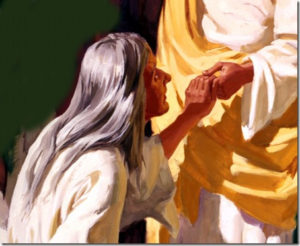Hello and welcome to summer! I just finished my master’s degree in Counseling Ministries. I feel like a free bird! I hope to blog more regularly now. In my New Testament course, I recently wrote a research paper on Jesus’ attitude toward women. Many people experience churches as patriarchal. I agree this is often the case. If Christians are meant to be followers of Jesus, we should think and act like him. Let’s take a look at what Jesus was really like, so we can strive to make the Church more like Jesus.
In today’s blog, I will talk about how Jesus treated women with compassion and lauded their actions over the actions of the men around them. Next week, I will talk about how, unlike other teachers of his day, he talked with women about theological topics. I will then draw conclusions about what the Church can and should do differently.
Cultural Norms Toward Women
Women in Israel during Jesus’ time had little status in a male dominated culture. They received very little education. In public, they were expected to be veiled – a woman with an uncovered head in public could give her husband cause for divorce. Women did not eat with male guests and a man talking to a woman in public was considered scandalous. These restrictions tended to force women to stay indoors and made any kind of religious leadership difficult. Females were not allowed to be priests or offer sacrifices. When determining if a quorum were present for worship, women could not be counted. They were separated from men during worship. Theologian Ben Witherington notes that there was no evidence that prior to Jesus’ ministry Jewish women were allowed to be disciples of a religious leader, much less travel with one. Women had little to do with the practice of Judaism. They were not allowed to recite the daily Shema or read the Torah in a synagogue.[1]
Against the backdrop of this patriarchal society, Jesus appeared. How did He interact with women?
He Ministered Compassionately to Them
Much of Jesus’ ministry focused on the needs of women. In one of Jesus’ first miracles, he healed Peter’s mother-in-law (Matthew 8:14-15). Later, he raised from the dead the son of the widow of Nain (Luke 7:11-17). He cast a demon out of the Syrophoenician woman’s daughter (Matthew 15:21-28), showed compassion for and saved the life of the woman caught in adultery (John 8:2 – 8:11). He healed the woman who had been bent over for 18 years (Luke 13:10-17).
One of the best examples of Jesus’ compassion toward women is demonstrated in the healing of the woman who had been hemorrhaging for twelve years (Matthew 9:18-26, Mark 5:21-43, Luke 8:40-56). The passage begins with Jairus, one of the rulers of a synagogue, beseeching Jesus to come heal his daughter who was deathly ill. As Jesus was heading to Jairus’ house, a woman who had been bleeding for 12 years made her way through the crowd to touch Jesus’ garment. While Jesus paused to help the woman, the little girl died. In putting these two stories together, we see the contrast in the social status of the two supplicants. Jairus was a Jewish male and leader in the community. The woman was poor and helpless, and because of her bleeding, she was considered unclean and separated from Israel’s religious life.
When the woman touched Jesus, he felt power leaving his body, and she felt herself instantly healed. Jesus could have continued on to Jairus’ house, but he stopped to look for the woman. When he did not immediately find her, he continued to look (Mark 5:31-32). When she finally came forward, Jesus praised her faith. He called her “daughter,” the only place in the gospels where Jesus used this word. In using it, he welcomed her back into the community of God.
While he was speaking, people came from Jairus’ house to tell him his daughter had died. Jesus told him that she was just sleeping and continued on. When he arrived at the house, he found her dead. Risking being made ceremonially unclean, Jesus touched her dead body and healed her. Theologian Mark Strauss posits that because Jesus was willing to touch and heal these two women, he challenged the social norms and the purity laws of the day, demonstrating his restorative power and the inclusivity of the kingdom of God.[2]
Jesus Lauded Women’s Acts as Examples to Men
There are many examples of Jesus acknowledging women for their examples of godly living. In Mark 12:38-44, Jesus compared the humility and generosity of a poor widow who put two copper coins in the treasury of the temple to rich people who put in large sums. Just before Jesus remarked on the poor widow, he warned his disciples not to behave like the experts of the law who seek honor for themselves while devouring the homes of widows. In these scenes, males are building themselves up and exploiting others while the woman gives self-sacrificially, demonstrating her trust in God.
Jesus used women to teach truth in parables. He told three sets of twin parables, where a parable focusing on men was told next to a parable about women. In Luke 15, Jesus told the parable of a man with the lost sheep (Luke 15:1-7), which he immediately followed by telling the parable of the woman with the lost coin (Luke 15:8-10). In Luke 18:1-18, the parable of the persistent widow was placed before the parable of the Pharisee and the tax collector. In Matthew 25:1-13, the parable about the wise and foolish virgins was placed before the parable of the bags of gold (Matthew 25:14-30). Theologian Millard Erickson notes that by telling these parables together, Jesus demonstrated that women can represent the righteousness of God as well as men can.[3]
One of the best examples of Jesus lauding a woman’s actions comes in the story of the woman who anointed Jesus. Mark 14 begins with the chief priests and the teachers of the law scheming to arrest and kill Jesus. Mark pauses to tell the story of a woman who anoints Jesus with pure nard kept in an alabaster jar, (Mark 14:3-9). People in Jesus’ time often used expensive alabaster bottles to store costly ointments. Nard was imported from India, and its expense might suggest an heirloom passed from one generation to the next.[4] Then, in Mark 14:10-11, the original story resumes with the chief priests paying Jesus’ disciple Judas to betray Jesus. In these verses, we see great irony. Those who should have known and revered Jesus (male priests, teachers of the law and even a disciple) instead plotted to destroy him. Only the woman in this scene saw Jesus for who he really was. Theologian Wongi Park remarks that not only was the woman a model disciple over the males, her act was the first act of remembrance, preparing the way for Jesus’ death. Only she understood and remembered Jesus. Because of her actions, Jesus praised her, saying that wherever the gospel is preached in the whole world, what she did will be told in memory of her.[5]
What We’ve Learned So Far
We’ve seen that in a patriarchal society where women are not even counted as humans, Jesus went out of his way to heal and care for them, and even lauded their actions over the religious leaders of the day. Join me next week as we see Jesus teaching women, something that was not done in that day. Then we will draw some conclusions about what the Church can and should do differently.
I pray you take these lessons from Jesus, and realize how much you are loved and valued.
Blessings to you,
Caroline
Footnotes
[1] Ben Witherington III, in The Anchor Bible Dictionary, Vol. 6, ed. David Noel Freedman (New York: Doubleday, 1992), 957.
[2] Mark L. Strauss, Mark – Zondervan Exegetical Commentary on the New Testament, ed. Clinton E. Arnold (Grand Rapids, MI: Zondervan, 2014), 237.
[3] Millard Erickson, The Word Became Flesh: A Contemporary Incarnational Christology (Grand Rapids, MI: Baker Book House, 1991), 581-582.
[4] Craig S. Keener, Matthew, The IVP New Testament Commentary Series, ed. Grant R. Osborne, D. Stuart Biscoe and Haddon Robinson, vol. 1 (Downers Grove, IL: InterVarsity Press, 1997), 366.
[5] Wongi Park, “Her Memorial: An Alternative Reading of Matthew 26:13,” Journal of Biblical Literature 136 no. 1 (2017): 143-144.





I appreciate what you have written here about Jesus and women. I have often felt that women tend to be closer to Jesus than the men I know. Perhaps it’s because we are less likely to use logic as men do. Thank you for sharing these insights.
You are very welcome!
One of the most astounding demonstrations of Jesus’ treatment of women as equal is the event of the Samaritan woman at the well. Other than Anna (the Prophetess of Lk.2:13), and Simeon (Lk.2:25ff), she is the first recorded to know that Jesus was the “expected Messiah,” and the first recorded evangelist. She told the whole town to come and see Jesus, and they did. This woman had three strikes against her: she was a woman, she was an immoral woman, and she was a Samaritan. The only thing you could add to these to put her on the absolute bottom of society would be leprosy! Further, we are told in John 4:4 “And it was so that he must needs go through Samaria.” It was a divine appointment. This women was at least one of Jesus’ reasons for going by way of Samaria to Jerusalem.
Very true. Thanks for your comment. I invite you to read part 2 where I talk about Jesus with the Samaritan woman. Caroline